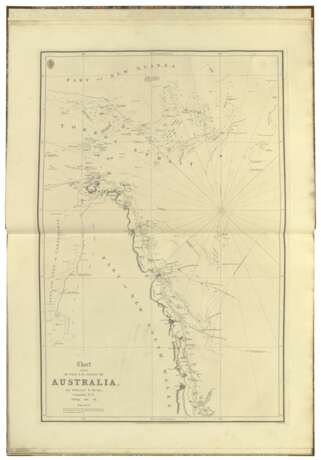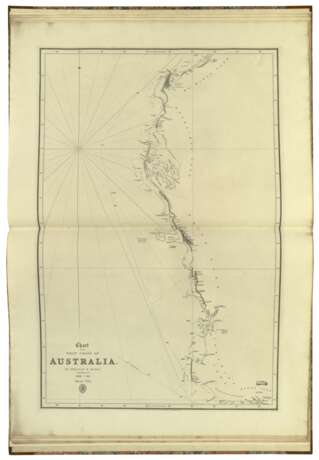ID 519378
Lot 87 | Phillip Parker King (1791-1856)
Estimate value
£ 5 000 – 8 000
[Atlas of King’s Charts of Australia.] London: Hydrographical Office of the Admiralty, 1824-1826.
A rare assemblage of King's important charts of the Australian coastline, completing the work of Cook and Flinders. Born on Norfolk Island in 1807 to Philip Gidley King (1758-1808), the third Governor of New South Wales, Phillip Parker was named after his grandfather Admiral Arthur Phillip (1738-1814), the first Governor of New South Wales and founder of the British penal colony which later became the city of Sydney. Hence his first name is spelled differently to his father’s, on account of his Australian heritage. King entered the Royal Navy in 1807, and in 1817 was put in charge of a survey of the coasts of Australia. He spent five years chiefly in the west, north and north-east, filling in the large remaining gaps in the early Dutch accounts of the north and west coasts, and revising and updating James Cook's charts of the east coast.
Despite their sponsorship of the Flinders voyage, the British Admiralty did not publish the charts to accompany Flinders' narrative of the voyage when it finally appeared in 1814 (see lot 84). However, when King's survey was finished in 1822, the Admiralty published the charts almost as soon as was practicable between 1824-1826. The present folio atlas contains the eight general charts and five north coast sheets compiled by him. King’s Narrative of a Survey of the Intertropical and Western Coasts of Australia describing the expeditions was written after the charts were published. Tooley, The Mapping of Australia, 801-808, 810-812, 814, 816.
Folio (669 x 485mm). 14 engraved charts, comprising 8 double-page charts numbered Sheets I-VIII, with Sheet VI present in both the first edition of 1825 and with the later 1838 issue loosely inserted, and 5 mounted single-page charts (a few charts with top-margins lightly dust-soiled, otherwise clean and fresh). Modern half calf.
| Address of auction |
CHRISTIE'S 8 King Street, St. James's SW1Y 6QT London United Kingdom | |
|---|---|---|
| Preview |
| |
| Phone | +44 (0)20 7839 9060 | |
| Buyer Premium | see on Website | |
| Conditions of purchase | Conditions of purchase |





